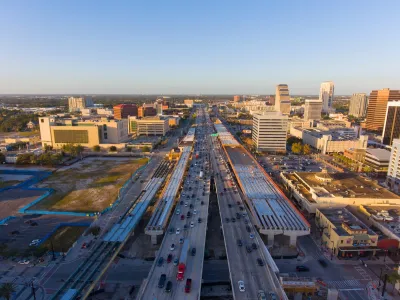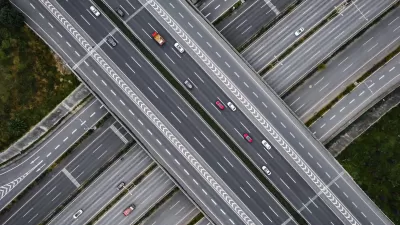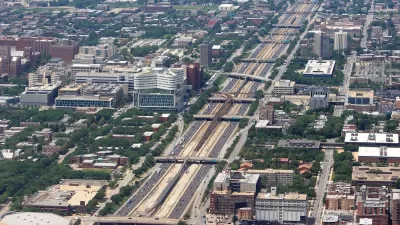Research from 50 major U.S. cities shows social connections are weakest in neighborhoods where highways are present.

A new study quantifies just how much urban freeways disrupt social networks, reports Eliana Perozo in Next City. The study assessed social connectivity in the 50 biggest U.S. cities and found the least social connections in neighborhoods with freeways.
This comes as no surprise to planners and advocates who have, for decades, underscored the negative impacts of highways on neighborhoods. By the U.S. Department of Transportation’s own estimates, interstates have displaced over one million people.
According to one of the study’s authors, “highways connect over long distances, but divide over short ones.” The study found examples of freeways that act as barriers both between communities of different races and intraracially. “Nashville’s I-40 – which split up a vibrant middle-class Black neighborhood, displacing about 80% of Nashville’s Black businesses, more than 600 homes and close to 1,500 people – is one of many such cases.”
Luca Aiello, lead author of the study, explained how this can translate into economic loss: “[Highways] limit social opportunities, and those social opportunities are connected directly to financial opportunities.”
In acknowledgement of the social, economic, and public health impacts of freeways, the federal Reconnecting Communities program was created under the 2021 Infrastructure Investment and Jobs Act to fund projects such as freeway removals and cap parks. Its future under the current administration, which rescinded USDOT guidelines that addressed equity, is unclear.
FULL STORY: Highways Block Social Connection. A New Study Shows Just How Much.

Study: Maui’s Plan to Convert Vacation Rentals to Long-Term Housing Could Cause Nearly $1 Billion Economic Loss
The plan would reduce visitor accommodation by 25,% resulting in 1,900 jobs lost.

North Texas Transit Leaders Tout Benefits of TOD for Growing Region
At a summit focused on transit-oriented development, policymakers discussed how North Texas’ expanded light rail system can serve as a tool for economic growth.

Why Should We Subsidize Public Transportation?
Many public transit agencies face financial stress due to rising costs, declining fare revenue, and declining subsidies. Transit advocates must provide a strong business case for increasing public transit funding.

How to Make US Trains Faster
Changes to boarding platforms and a switch to electric trains could improve U.S. passenger rail service without the added cost of high-speed rail.

Columbia’s Revitalized ‘Loop’ Is a Hub for Local Entrepreneurs
A focus on small businesses is helping a commercial corridor in Columbia, Missouri thrive.

Invasive Insect Threatens Minnesota’s Ash Forests
The Emerald Ash Borer is a rapidly spreading invasive pest threatening Minnesota’s ash trees, and homeowners are encouraged to plant diverse replacement species, avoid moving ash firewood, and monitor for signs of infestation.
Urban Design for Planners 1: Software Tools
This six-course series explores essential urban design concepts using open source software and equips planners with the tools they need to participate fully in the urban design process.
Planning for Universal Design
Learn the tools for implementing Universal Design in planning regulations.
City of Santa Clarita
Ascent Environmental
Institute for Housing and Urban Development Studies (IHS)
City of Grandview
Harvard GSD Executive Education
Toledo-Lucas County Plan Commissions
Salt Lake City
NYU Wagner Graduate School of Public Service





























